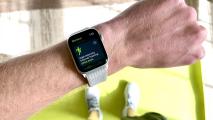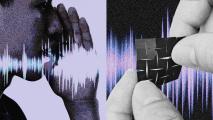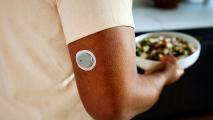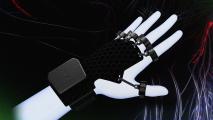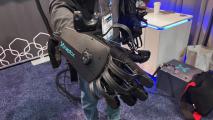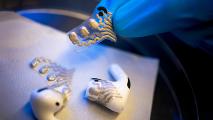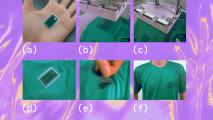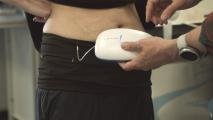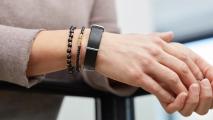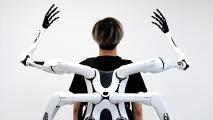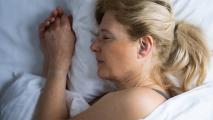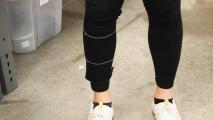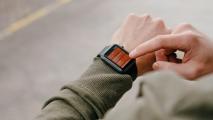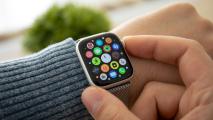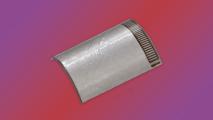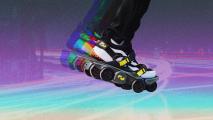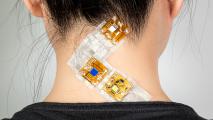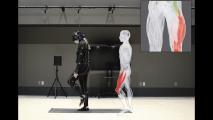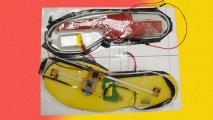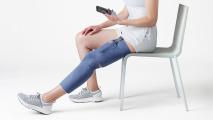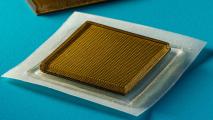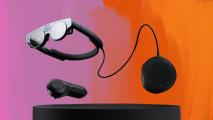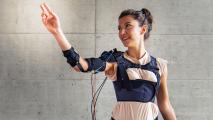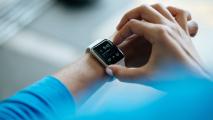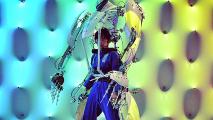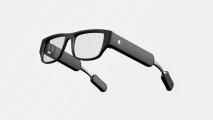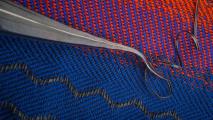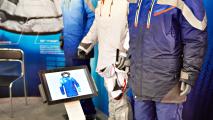Field: Wearables
Today’s wearables track your body. Tomorrow’s could treat it.
Wearables that treat health issues, track countless biomarkers, and last far longer than today's devices are on the horizon.
How smart devices helped me unlock hidden health wins
By measuring many different body metrics, smart health devices can help support the mental game as much as the physical fitness gains.
How Brilliant Labs CEO is creating a “symbiosis of humanity and artificial intelligence”
CEO Bobak Tavangar discusses the philosophy behind Brilliant’s latest device, Frame, and his vision for the future of AI.
AI-powered wearable “speaks” for people with vocal cord problems
Bioengineers at UCLA are developing an AI-powered wearable that could make it easier for people with vocal cord problems to talk.
FDA approves first over-the-counter CGM
The FDA-approved Stelo is the first continuous glucose monitor (CGM) available without a prescription in the US.
Tech hacks the nervous system to bring touch to virtual reality
Afference's Phantom conducts electrical signals through nerves in the fingers to convince your brain it feels objects in virtual spaces.
We tested the most advanced haptic gloves in the world
HaptX's new technology uses tactile and force feedback to allow people to "feel" virtual objects with high fidelity.
These earbuds analyze brain activity and sweat content
A flexible sensor turns a pair of earbuds into a health monitoring device capable of recording brain activity and analyzing sweat.
New workout sensor tells you when you’re at risk of heat stroke
A wearable that alerts users when they're at risk of heat stroke could be a game changer for health monitoring, if it can become commercial.
New study shows how electricity can turn on genes
A prototype wearable demonstrates a novel way to trigger gene expression: by zapping cells with electricity.
There’s now a wearable that can track your stress hormones
A wearable device called U-RHYTHM makes it easy for researchers to see how stress hormones ebb and flow over 24 hours.
This new watch-like wearable measures blood pressure 24/7
A Swiss company has developed a lightweight, comfortable bracelet which can provide constant and accurate information about blood pressure.
This robotic arm study is preparing us for our cyborg future
A new study at the University of Tokyo aims to find out how people feel using robotic arms — and sharing them with others.
Earbud-like tech will monitor sleep for signs of Parkinson’s
An EEG device that’s worn in the ear during sleep could help doctors diagnose Parkinson’s and Alzheimer’s long before symptoms appear.
NASA funds first wearable to measure muscle atrophy
The first wearable designed to monitor muscle atrophy could help NASA astronauts stay strong during long space missions.
Batteries not included: How your own body could power wearables
Batteries are the weak link for wearable and implantable devices. But what if you could harvest energy from the heat, sweat or vibrations of the wearer?
Apple has a secret project to help people with diabetes
Apple is developing tech that could put noninvasive blood glucose monitoring right into its smartwatches, according to a Bloomberg report.
Amazon TVs can now stream directly to cochlear implants
Amazon is making it possible for people with hearing impairments to stream audio from its smart TVs directly into their cochlear implants.
This tiny device lets you see your heart while exercising
A new wearable heart monitor powered by AI provides accurate and continuous measurements of cardiac performance at all times.
World’s fastest “shoes” increase walking speed by 250%
Shift Robotics is taking pre-orders on Moonwalkers — $1,400 “shoes” that let you walk 2.5x faster without expending any extra energy.
Just a few short bursts of physical activity each day might yield huge health benefits
Researchers tracked 25,241 non-exercisers wearing accelerometers to find out of brief bursts of activity lowered their risk of dying.
“SkinKit” lets ordinary people build their own “smart tattoos”
"SkinKit" smart tattoos are wearable devices that collect data directly from users' bodies and display useful information in real time.
New VR body suit lets you see inside your body while you exercise
A system for monitoring motion and muscle engagement could aid the elderly and athletes during physical rehabilitation.
Shoe wearable could help Parkinson’s patients avoid falling
Data-collecting sensors in shoes can predict a Parkinson’s patient’s fall risk almost as accurately as standard walking tests.
You no longer need a prescription to buy hearing aids in the US
The FDA is making over-the-counter hearing aids available to Americans, potentially making the devices cheaper and more accessible.
Lightweight bionic zaps muscles to help you walk longer, faster
The AI-powered Neural Sleeve electrically stimulates the leg muscles to help people with mobility issues walk faster and longer.
MIT’s new ultrasound sticker lets you see inside your body
MIT researchers have created an ultrasound sticker that can continuously monitor a person’s organs and tissues for up to 48 hours.
Magic Leap reveals release date, price for new AR glasses
Two years after laying off half of its staff, Magic Leap is back with a new pair of AR glasses, the enterprise-focused Magic Leap 2.
“Muscle shirt” increases arm endurance by more than 200%
The Myoshirt acts like “wearable muscles,” using sensors and AI to help people with upper-limb impairments move their arms.
Wearable tech: eating and playing our way to a longer lifespan
Wearable devices can detect the specific molecules in food and our body’s response to it, allowing us to make better dietary decisions.
Could a former NASA scientist’s “sunlight glasses” protect your vision?
A former NASA scientist has co-developed a pair of glasses designed to prevent myopia by glowing in a precise wavelength of visible light.
New exoskeleton lets you enter the boxing ring as a robot
Japanese company Skeletonics has developed a new exoskeleton that lets you enter the boxing ring as a nine-foot-tall robot.
Nimo smart glasses are like a PC for your eyes
India-based startup Nimo Planet is now accepting reservations for its Nino smart glasses, which let wearers view six virtual screens.
A fabric that “hears” your heart’s sounds
An MIT team has designed an “acoustic fabric" to convert sound vibrations into electrical signals.
The future of clothing could save your life
Smart textiles may not be gaining ground with fitness gurus, but they are helping patients manage chronic conditions and preventatively monitor their health from home.
Wearable robot helps people with paralysis sing
Seoul National University researchers have built a wearable robot that helps people with spinal cord injuries breathe, cough, and sing.
